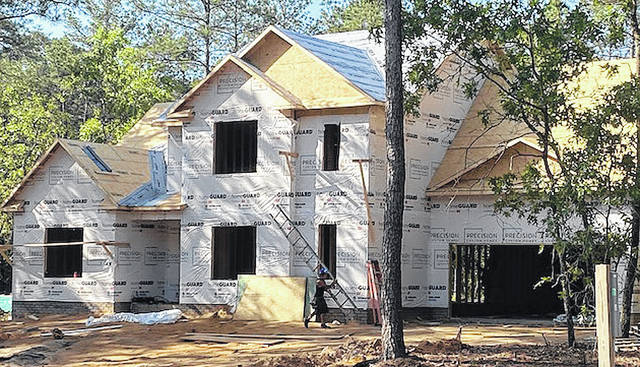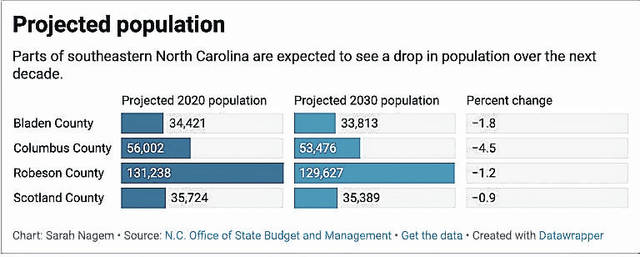
Crews work on a home just outside the gates of Deercroft, a golf course community in the Scotland County town of Wagram.
Influx of people makes market boom
Phillip Britt can barely keep up with everyone who wants to move to Robeson County.
Before the coronavirus pandemic, buyers had plenty of options, with about 400 homes for sale in the county at any given time, according to Britt, a Realtor. For the past several months the number has been more like 60 or 65, he said.
Yes, the housing boom is indeed booming in rural Southeastern North Carolina, which hasn’t experienced significant growth in decades.
“We used to not see it so much trickle into the smaller areas,” Britt said of the demand for homes. “However, we have this time around.”
Much of North Carolina is seeing an influx of people, including those who opted to leave crowded, expensive cities like New York and San Francisco during the pandemic. While the housing market is extra hot in the state’s biggest metro areas, including Charlotte and Raleigh, more potential homebuyers are also considering areas better known for corn fields and hog farms than residential developments.
Now, as low interest rates continue to drive demand, economic development leaders in N.C. counties along the South Carolina border are asking themselves an increasingly pressing question: How can they get more homes built?
“We’re begging for Realtors to find a builder to start building spec houses,” said Mark Ward, economic development director for Scotland County, home to about 36,000 people and roughly 45 miles southwest of Fayetteville.
(Unlike custom homes, in which buyers make many of the design decisions up front, spec houses are built using pre-set plans and are typically sold at a lower price).
POTENTIAL PARTNERSHIPS
One way to attract spec-home builders could be through public/private partnerships, according to Ward and Chuck Heustess, executive director of the nonprofit Bladen’s Bloomin’ Agri-Industrial group in Bladen County.
In more populated areas, roads, and water and sewer lines might already be in place when developers and builders arrive. But that’s often not the case in rural communities, which means an extra expense.
So maybe counties could use tax dollars to foot the bill for the infrastructure, Heustess said.
“If you can get those costs out of the way for the developers to where it’s more economically feasible for them and less risk for them, maybe we can get some of that housing in our area,” Heustess said.
In Scotland, perhaps the county could buy the land for new homes, in addition to running water and sewer lines, Ward said. The investment would be worth it because the new homes would increase the tax base.
But Shaun Gardner, owner of Precision Custom Homes in Fayetteville, said it might take more than financial incentives.
Gardner’s company is building homes in Deercroft, a gated golf-course community in the Scotland County town of Wagram. They’re selling for up to $320,000, he said, and he plans to build about 10 a year.
With the high cost of lumber and other building materials, Gardner said it makes more sense financially to build larger homes, such as those in Deercroft that are up to 2,600 square feet.
“It’s really hard to build smaller houses right now,” he said. “It’s almost impossible.”
But most importantly, builders need to feel confident that there is enough demand for spec houses, Gardner said.
“If somebody’s willing to take the risk, it could happen,” he said of reasonably priced housing developments in Southeastern North Carolina. “Somebody’s going to have to be the first mover.”
While conditions might be great now for a burst of growth, the populations of four Southeastern North Carolina counties — Bladen, Columbus, Robeson and Scotland — are expected to drop over the next decade, according to projections from the N.C. Office of State Budget and Management.
Columbus County, now home to about 56,000 people, is expected to see the biggest drop, and could lose nearly 5% of its population.
Even so, one company has big housing plans for the area. But neighbors aren’t happy — a stark reminder that barriers to growth, even in rural communities, often come from within.
NEIGHBORS PUSH BACK
Wilmington-based Thriving LLC wants to put 48 double-wide mobile homes on about 44 acres near Whiteville.
While some say the development would provide desperately needed homes, nearby residents say they are worried about traffic and the potential impacts on schools and water quality.
“We have tractors and combines going up and down the road at all times,” Patricia Wright told Columbus County commissioners earlier this month, according to The News Reporter. “It’s not a good fit for our farming community.”
Jackie Ray-Pierce, owner of J. Ray Realty in Whiteville, said she hopes county leaders will take developers up on offers to build. The local real estate market hasn’t been this busy since the housing bubble of the early 2000s, she said.
Some people are moving to the area from northern states, drawn by warmer weather and the proximity to the beach, Ray-Pierce said. Others who live on the coast are moving 50 miles or so inland to avoid homeowners association fees and property restrictions.
The problem is that “there’s really just nothing here to move to,” she said.
Demand is so intense that some homes are selling for $30,000 over the asking price — a phenomenon happening in cities and suburbs but one that has been unheard of in this part of the state.
The county hasn’t seen any new subdivisions in years, and rental options are just as scarce. Columbus County needs more apartments, Ray-Pierce said.
“It’s just not feasible for, say, a new teacher moving in,” she said.
Surrounding counties don’t have enough rental options, either. The problem worsened in Robeson County when hurricanes Matthew and Florence ripped through the area, destroying some homes and leaving others in need of major repairs, according to Britt, of Britt & Co. Real Estate Professionals.
Displaced from their homes, many people turned to rentals.
“That demand went crazy high overnight, basically,” Britt said.
LOOKING AHEAD
A couple of years ago, homes in Robeson County, home to Lumberton, typically sold for about $99,000, according to Britt. Now they’re selling for about $125,000.
Despite the higher prices, even first-time homebuyers want into the market. Some are using their tax refunds and federal stimulus payments while interest rates are historically low, Britt said.
But the competition is tough with so few homes for sale.
“When buyers lose out on 10 houses, it’s human nature to get frustrated,” he said. “So the need is there.”
Heustess said he hopes to present some ideas in the coming months to Bladen County leaders about possible ways to create more housing. He’s pushing for a new approach, using public money to lure private developers.
In the past, the area saw more mobile home parks, Heustess said. But stricter infrastructure rules have slowed that kind of growth.
And that might not be a bad thing, he said.
“You really can’t allow people to just throw trailers up on farmland and invite people to live in them,” Heustess said.
The Border Belt Independent is a nonprofit, online newsroom that focuses on issues and challenges that affect Bladen, Columbus, Robeson, and Scotland counties.







